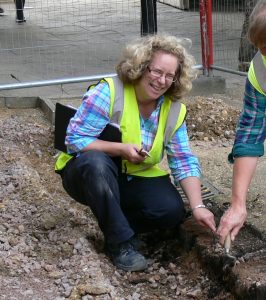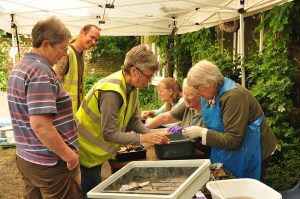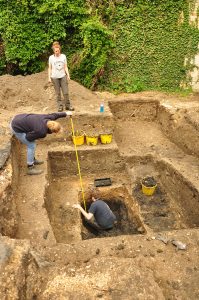Digging the Cathedral

In a recent issue we talked to Cathedral Architect Stephen Oliver about the work he does at Peterborough Cathedral and its Precincts. This issue, we talk to Cathedral Archaeologist Dr Jackie Hall, who frequently works with him, about Anglo-Saxon foundations, finds from a medieval pond and the mystery that is Gunton’s Vault...

Jackie Hall
Most archaeologists have a specialism within their subject – how would you describe yours?
I would describe myself as a buildings archaeologist, so I’m as likely to be found up scaffolding as I am below ground, although lately it has been below-ground projects at Peterborough. Not all the buildings in the precincts belong to the Cathedral, and so sometimes I’m asked to look at the buildings belonging to others. For instance, the old almshouse needed recording and analysis, before recent changes to it, and that turned into a fascinating project.
My pre-cathedral archaeology specialism was in architectural stone and monastic buildings, and occasionally I still do work on loose stones, as well as organising conferences or giving lectures. At the moment, I’m writing a short section for the Corpus of Anglo-Saxon Stone Sculpture, for example. But like Cathedral Architect Stephen Oliver, I’m also archaeologist for another cathedral, Southwark Cathedral. So, I don’t work full time in Peterborough, and I do other archaeological work. We’re paid a small retainer, and after that it’s on a by-project basis, as work is required. This can cover a wide range, but my specialism remains medieval and later buildings and the archaeology underneath.
Tell me what your basic remit is in relation to Peterborough Cathedral…
For centuries, now cathedrals have had architects; that was formalised in 1990, when it became a legal obligation to have an architect. And at the same time, it became a legal obligation to have an archaeologist. That formed part of what’s known as the Cathedrals Measure, which resulted from a review of the Ecclesiastical Exemption. There are five religious groups or denominations in England, all Christian, which are exempt from certain provisions of the planning acts, so they don’t have to apply for listed building consent. Instead, they have a parallel permission structure – I would say it’s probably more robust than the secular structure, partly because the secular structure has been under so much pressure in recent years. Cathedrals must apply for permission either from the Fabric Advisory Committee or, if it’s quite a major piece of work, through the national committee, which is the Cathedrals Fabric Commission for England (CFCE). My role is to advise the Cathedral on its archaeology, to help limit any destruction, and to make sure that anything that must be destroyed is properly recorded.
I know that Stephen does a quinquennial – or five-yearly – inspection. Do you have to do that too?
I don’t do a quinquennial inspection in the same way. The architectural quinquennial focuses on the condition of the buildings, and for Peterborough I’ve always added archaeological comments to that to say ‘I think we should record this’ or ‘Please look out for that’. And sometimes there are more major projects that come up. But the rules are surprisingly strict regarding below-ground archaeology. Anything regarding archaeology requires CFCE permission, and in certain parts of the precinct you’ll also require Scheduled Monuments Consent from Historic England. So there are multiple layers of protection – more arduous, I would say, than in the secular world. In a major monastic and post-monastic complex of buildings, you don’t have to go very far before you find you’re into archaeological layers. In the cathedral church, for instance, the 12th century foundations are lying around everywhere! Also, if significant work is carried out on the building, then I’d record that as well, because that might have information about its history, the series of repairs over centuries, different types of material used, and so on.

Community Archaeology Dig
What’s the usual archaeological process if there is something that you think is worth investigating?
In an ideal world, you’ll start off with a short archaeological report – a desktop assessment – and if everyone decides they want to go ahead then you’ll do a trial hole, unless the whole dig is going to be very small anyway. This will require CFCE permission and, in certain areas of the precinct, it will need Scheduled Monument consent, as well. We needed that, for instance, just to repair a garden wall. It needed underpinning, but it was a historic garden wall – it had medieval foundations on one side, as we discovered – and for that we did two trial holes. They were actually for the structural engineer, but I dug them with one of the builders so that it could be recorded archaeologically, and then drew that up and wrote a report – which also served as an indication of what we were likely to find when the whole wall was underpinned. And then you go through another round of applications and permissions, and then do the dig proper. I’m in my 50s now, so this time, I put it out to tender and got some nice, young, fit archaeologists to do the hard work! And it was really hard work; it was almost solid clay, and even they struggled a bit…
This has been an area of intense activity over a very long period of time. Does that mean there are new things continually coming to light?
Because we know a lot about it, I should have a reasonable expectation of what I’m going to find. It shouldn’t come as a complete surprise, or I’m not doing my job properly! But if it does, it’s likely to be something incredibly exciting, like treasure trove. But there is certainly a wealth of archaeology.
The trial holes for the wall were really deep – well over a metre – and we barely got through the medieval period. We certainly didn’t reach natural [the layer at which there is no evidence of human impact on the environment] so we’ve signs of occupation here that just go deeper and deeper. It would be amazing to do a proper excavation here that goes all the way through all the archaeology, but I don’t think that’s very likely to happen. More often my role is to put a curatorial hat on and to attempt to limit the impact of any intervention on the archaeology, so that it’s preserved for future generations.

Community Archaeology Dig
In recent years you were involved in a community archaeology project within the precincts, where members of the public, young and old, had the chance to take part in an archaeological dig. Tell us about that…
We did that back in 2016, in the Garden House area, and it was really, really interesting. It came about because of the Heritage Lottery Fund project – the big project when we got the ramp into the West Front, the new visitor centre and new interpretation. Part of that project was outreach, and one of the things we were lucky enough to do within that was a community archaeology dig. We obviously had to choose an area where we would get permission and which fitted in with what the Cathedral wanted, and the Garden House area was perfect for that, partly because there was already some development being thought of in the future. Normally with development archaeology, you ask for an estimate for what you think it will cost, but in this case we had a set sum of money, so we went out to tender and basically asked ‘What can you give us for £50,000?’ We put in our expectations in terms of reaching to adults and children, and how the education department would work with them, and ultimately the job went to the Cambridge Archaeological Unit. They did a brilliant job for us. The site was mostly a medieval pond filled in in the 1820s, so I wasn’t too worried about damaging archaeological layers. But there were so many finds! You expect quite a lot from pond fill because people are always chucking things in ponds, and this has happened for centuries. On the other side of the site, though, away from the pond, there was this massive, early 20th century kitchen dump; broken crockery, milk bottles, clotted cream jars, just so much stuff! Our younger volunteers absolutely loved it because they were finding so much. And the older volunteers loved it too, because they could sit and just wash these finds to their hearts’ content! Going further back, there was also late medieval pottery and all sorts of different finds types, such as glass, lead, stone. It was a lot of fun, but we also got some useful information about the drainage on the western side of the site, below the kitchen dump. At the top end of the pond, we were also hoping that we might catch some slight evidence of the 11th century precinct wall boundary. And we did. It was mostly destroyed by the pond, but there were still tiny bits of the hard yellow mortar used to build it.
When we talked to CathedralArchitect Stephen Oliver he mentioned a curious space below the Cathedral called ‘Gunton’s Vault’. What can you tell us about that?
We call it Gunton’s Vault because the first textual mention of it is in a history written in the 17th century by Peterborough clergyman and antiquarian Simon Gunton. It was then rediscovered by J.T. Irvine in 1883, who recorded the vault in much more detail. He came from Shetland and was a Fellow of the Society of Antiquaries of Scotland, and became clerk of works at Peterborough Cathedral during the restoration work of the 1880s, when the tower was taken down and rebuilt. He worked with a lot of well-known architects of the time, and he had a really archaeological mind. So, he was responsible for excavating and recording the Anglo-Saxon church that was partly underneath the tower when that came down; we know so much from his records that we wouldn’t otherwise know. This included Gunton’s Vault, although it’s the local papers that tell us about finding pikes and leather gloves down there. These date from 1643, when Cromwell’s forces ransacked the Cathedral, and destroyed the altarpiece – painted fragments from the broken 14th century altarpiece were thrown into the vault as well. The Cathedral kept the stonework but we don’t know what happened to those pikes and gloves. Today, we would treasure those as well and probably put them on display. But, in the 1880s, they may have wanted to just get rid of this reminder of the destruction of so much of the Cathedral fabric.
So what is Gunton’s Vault? A crypt? Or something else?
We just don’t know. It’s a strange beast, and we’re not sure what it’s for. Part of it is quite late – post-Irvine – and it looked like it had been turned into an area to store ashes (although this didn’t happen). But that’s clearly not its original use. So we just don’t know. Perhaps it was just to store treasure during times of trouble. Obviously, it postdates the well-known attack by Hereward around 1070, when he went off with all the treasures of the Abbey. But you can see how political events and uncertainties might influence the monks’ decision to build a secure tunnel – because it’s not big enough to be a crypt. It’s so low, you have to crouch to be in it. Steven is quite tall and I think he really struggled. I’m five foot two but even I was struggling!
It is a sort of T-shaped passage – well, more J-shaped actually, but it looks like there’s another part going off from it. I think everyone who sees it thinks ‘Gosh, what’s this…?’ It would be nice to link it with features like the Anglo-Saxon passages at Repton or Hexham, but I don’t think that’s realistic. It doesn’t look or feel old enough; the tooling and the stonework are so straightforwardly medieval.
So how old do you think it could be?
I don’t think I’d want to put a definite date on it, but I will say later than the building of this church, and later than the crossing, which it is very close to, but avoids. So later than 1170, which would fit with the fine vertical tooling, but it could be centuries later.
Is it possible there’s more of it to be discovered?
Possibly, where it looks like it might turn off from the J section…
 Does the Cathedral have any other underground secrets?
Does the Cathedral have any other underground secrets?
Yes, there’s the Victorian vault, where you can see the Anglo- Saxon foundations. I just get so excited, you know, every time I go down there, knowing that I’m treading on the plaster floor that the Anglo-Saxons trod. If you imagine the crossing tower with its four big piers, it’s around the South West pier. This passage was created by the Victorians so that the early foundations remained accessible after they took down and rebuilt the central tower, which I think was an absolutely wonderful thing to do. And I gather, years ago, you used to be able to go down there on Sunday afternoon for sixpence! I would so love for people to be able to see it still, but unfortunately it’s really fragile. It’s not consolidated at all, and there’s no way for people to access it without damaging the archaeology.
Most of the time archaeology is below ground, but of course with a cathedral the most major part is right there, above ground…
That’s why I love being a buildings archaeologist, because you look at the layers in the building, you can see how it was built, which bits are built when, where the repairs are… Why did they do that? And where did the materials come from? It overlaps with architectural history and art history in ways that below-ground archaeology rarely does. Lots of people would rather do the trowel-based archaeology, and that’s fine, but obviously I think everyone should appreciate buildings archaeology! And it’s always important to tie in below-ground archaeology with the buildings above. During the community dig, there was one really rainy day, and everyone was wet and feeling a bit miserable, so the supervisors said ‘Please would you give a tour to these archaeologists and volunteers?’ So I did that. And they were all so interested to learn about how I see the building – and some had questions which I couldn’t answer, because there’s always more to learn about a major cathedral like Peterborough. But I did get to answer many queries, for instance the purpose of the holes in the vaults of the west transept, which were to pull the bells up through. And then you’ve got the little, tiny holes still there for the bell ropes, showing the ringers used to ring the bells from the ground. It’s things like that that people maybe don’t usually look at, but which tell you about the building. It’s just another way of seeing it, isn’t it?















